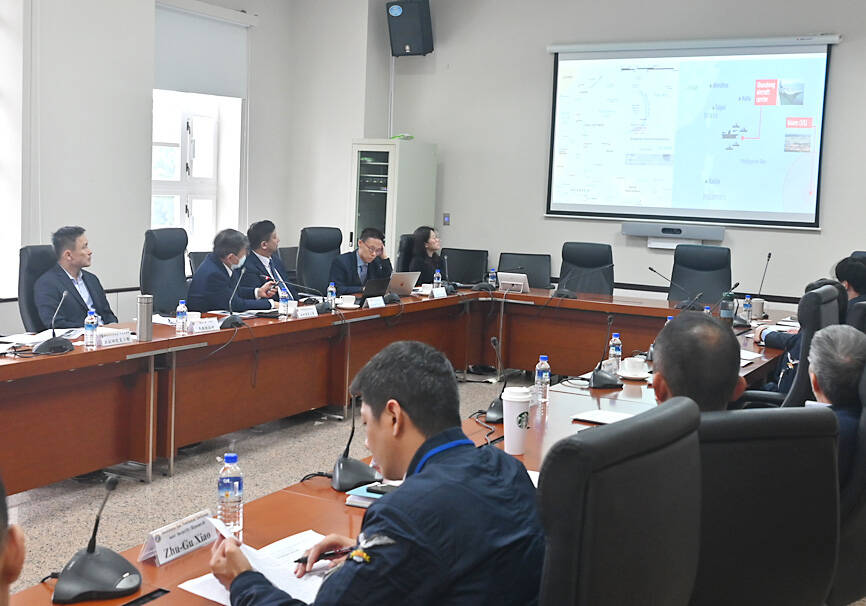Taiwan’s regulations for controlling maritime borders with China could worsen the effect of Chinese legal warfare, an academic said on Monday at a forum held by the Institute of National Defense and Security Research (INDSR) in Taipei.
In July, a Chinese cargo ship sailed into restricted waters and refused orders from Coast Guard Administration personnel for it to turn back, claiming that Taiwan has no authority as it is “only a province, not a country,” said Tsai Chi-ting (蔡季廷), a political science associate professor at National Taiwan University.
Such actions are part of Beijing’s legal warfare to assert its claims over Taiwan’s waters and manufacture an interpretation of international law favorable to its interests, he said.

Photo: Wang Yi-sung, Taipei Times
Additionally, the use of China’s numerous civilian cargo ships to breach the nation’s maritime borders would impose high operational costs on Taiwan’s coast guard, Tsai said.
Another hurdle for dealing with Chinese legal warfare effectively is the Act Governing Relations Between the People of the Taiwan Area and the Mainland Area (臺灣地區與大陸地區人民關係條例施行細則), he said.
This law, which regulates coast guard interactions with Chinese civilian ships, stipulates that Taiwan and China are not separate countries, making it difficult for Taipei to invoke international law, Tsai said.
The government has to balance security with special political considerations in handling aggressive behavior from China’s civilian vessels, he said.
“This regulatory approach gives Chinese vessels a greater range of options to test Taipei’s ability to control restricted or prohibited waters in the seas surrounding Taiwan,” he said, citing China’s use of sand dredgers near Lienchiang County.
Some Taiwanese proposed expanding the nation’s restricted maritime zones in response to illegal dredging by China, but others believed that it could provoke Beijing into making even more incursions and could be problematic in terms of international law, he said.
These disagreements resulted in a dissipation of interest in the issue before it was properly resolved, Tsai said.
The Chinese People’s Liberation Army Navy’s (PLAN) strategy is to erode Taiwan’s control over its environs by degrees, successfully probing the Taiwan Strait median line, the southwestern air defense identification zone (ADIZ) and Taiwan proper’s 24 nautical mile (44.5km) perimeter, INDSR associate research fellow Huang Chung-ting (黃宗鼎) told the forum.
There is a risk of conflict in the waters surrounding Taiwan and in the South China Sea, he said.
Beijing’s new “10-dash line” claims enveloped the eastern seas of Taiwan proper and the Bashi Channel, showing a linkage between the Taiwan Strait and the South China Sea in Chinese strategy, Huang said.
This means PLAN tactics in the South China Sea could be used in Taiwanese waters, he said.
The Chinese navy’s constant exercises and drills in the seas east of Taiwan proper and in the Philippine Sea indicate that Chinese President Xi Jinping (習近平) intends to strengthen his forces to a point that they could prevent the US from intervention, said Lin Cheng-yi (林正義), a research fellow at Academia Sinica’s Institute of European and American Studies.
Keeping the Chinese armed forces confined outside the first island chain would be a boon for any US president’s ability to handle or prevent a crisis occurring in the South China Sea, East China Sea or the Taiwan Strait, Lin said.

The brilliant blue waters, thick foliage and bucolic atmosphere on this seemingly idyllic archipelago deep in the Pacific Ocean belie the key role it now plays in a titanic geopolitical struggle. Palau is again on the front line as China, and the US and its allies prepare their forces in an intensifying contest for control over the Asia-Pacific region. The democratic nation of just 17,000 people hosts US-controlled airstrips and soon-to-be-completed radar installations that the US military describes as “critical” to monitoring vast swathes of water and airspace. It is also a key piece of the second island chain, a string of

A magnitude 5.9 earthquake that struck about 33km off the coast of Hualien City was the "main shock" in a series of quakes in the area, with aftershocks expected over the next three days, the Central Weather Administration (CWA) said yesterday. Prior to the magnitude 5.9 quake shaking most of Taiwan at 6:53pm yesterday, six other earthquakes stronger than a magnitude of 4, starting with a magnitude 5.5 quake at 6:09pm, occurred in the area. CWA Seismological Center Director Wu Chien-fu (吳健富) confirmed that the quakes were all part of the same series and that the magnitude 5.5 temblor was

Taiwan will now have four additional national holidays after the Legislative Yuan passed an amendment today, which also made Labor Day a national holiday for all sectors. The Chinese Nationalist Party (KMT) and Taiwan People’s Party (TPP) used their majority in the Legislative Yuan to pass the amendment to the Act on Implementing Memorial Days and State Holidays (紀念日及節日實施辦法), which the parties jointly proposed, in its third and final reading today. The legislature passed the bill to amend the act, which is currently enforced administratively, raising it to the legal level. The new legislation recognizes Confucius’ birthday on Sept. 28, the

The Central Weather Administration has issued a heat alert for southeastern Taiwan, warning of temperatures as high as 36°C today, while alerting some coastal areas of strong winds later in the day. Kaohsiung’s Neimen District (內門) and Pingtung County’s Neipu Township (內埔) are under an orange heat alert, which warns of temperatures as high as 36°C for three consecutive days, the CWA said, citing southwest winds. The heat would also extend to Tainan’s Nansi (楠西) and Yujing (玉井) districts, as well as Pingtung’s Gaoshu (高樹), Yanpu (鹽埔) and Majia (瑪家) townships, it said, forecasting highs of up to 36°C in those areas